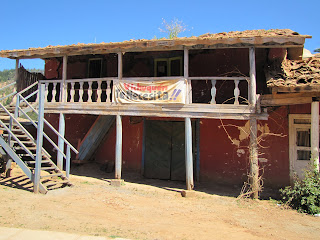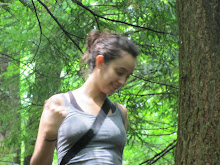Even though my parents have returned to the states and the trip we took to the Lago Vichuquen area happened a week ago, I still want to talk about it. I want to focus this post on the topic of earthquake and tsunami destruction. Even though the humongous earthquake that shook up a large portion of the country happened eight months ago, Chile is still dealing with the aftermath. I have noticed bits of destruction that the earthquake left behind since I arrived here. Both in Rengo and in Santiago there is still a lot of reconstruction going on. Especially in smaller towns like Rengo, it is easy to find a plethora of buildings sporting huge cracks, evidence that the steadiness of their foundation was greatly tested. But it wasn't until this past weekend that I saw firsthand the damage of the tsunami.
We visited a few towns expecting to see damage from the earthquake so I can't say I was too surprised, but for some reason I've found that I often forget about the tsunami. So it was very interesting to visit a few towns on the coast such as Iloca and see firsthand how incredibly powerful the sea can be. We ate in two different restaurants with beautiful ocean views, and both were filled with water that day in February after the earthquake. Most of the businesses on the seaside (of the area we visited) have opened again, but they were all certainly affected. It's pretty strange to be eating a delicious meal, watching the waves come in and pull back, while imagining what the very place I was sitting in must have looked like when the tsunami hit.

The sand was covered with rocks and seashells but you could also find other things such as glass, pieces of ceramic and tile that I'm sure came from people's houses.

We also visited the town of Vichuquen which was greatly affected by the earthquake. It's a small town with a strong Native heritage, it was the southern most point settled by the Incas. Therefore Vichuquen was made up of mostly very old adobe houses. Sadly, most of those buildings did not hold up after the earthquake. Wood is able to shift and sway with the moving earth, but building made from mud and clay such as the adobe style do not have the same flexibility as wood, and often end up crumbling and falling to the ground. Unfortunately this happened to much of Vichuquen. While I can see that the clean up effort and some reconstruction has begun, there is still so much to be done. Because the adobe style is so important to the town's heritage and legacy, they hope to preserve that as they re-build. However, changes will probably have to be made, because this is Chile and earthquakes happen all the time. I know that one option they are considering is to rebuild buildings using wood and materials that hold up better to the shaking ground, but still keep the adobe style in the front.

I'm not really sure what these markings mean but I'm guessing it has something to do with reconstruction. It reminds me of the grim markings that were all over houses in New Orleans after Katrina, indicating the number of bodies found inside.

Seeing the damage that remains after eight months just reminds me how powerful and unpredictable nature is. I think it's very important to remember that we as human being don't and can't control nature. We must respect and revere the natural forces because our strength and power is nothing compared to that of the wind, the sea, the earth.





No comments:
Post a Comment